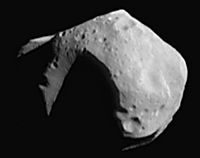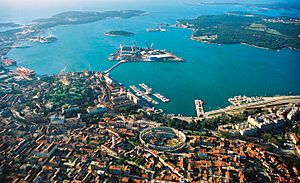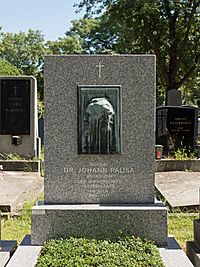Johann Palisa facts for kids
Quick facts for kids
Johann Palisa
|
|
|---|---|
 |
|
| Born | 6 December 1848 Troppau, Austrian Silesia, Austrian Empire
|
| Died | 2 May 1925 (aged 76) |
| Nationality | Austrian |
| Alma mater | University of Vienna |
| Known for | asteroids |
| Awards | Lalande Prize, 1876 Valz Prize, 1906 |
| Scientific career | |
| Fields | astronomy |
| Institutions | University of Vienna |
Johann Palisa (born December 6, 1848 – died May 2, 1925) was an Austrian astronomer. He was born in Troppau, which was then part of the Austrian Empire and is now in the Czech Republic.
Palisa was very good at finding asteroids. He discovered 122 of them! His first asteroid, 136 Austria, was found in 1874. His last was 1073 Gellivara in 1923. Some of his famous discoveries include 153 Hilda, 216 Kleopatra, 243 Ida, 253 Mathilde, 324 Bamberga, and the near-Earth asteroid 719 Albert.
What makes Palisa special is that he found all these asteroids just by looking through a telescope. He didn't use photography, which is how most asteroids are found today. He is still the most successful person to discover asteroids without using cameras.
About Johann Palisa
Johann Palisa was born on December 6, 1848, in Troppau. This city is now called Opava and is in the Czech Republic.
From 1866 to 1870, Palisa studied mathematics and astronomy at the University of Vienna. Even though he didn't officially graduate until 1884, he started working as an assistant at the university's observatory in 1870. A year later, he got a job at an observatory in Geneva.
In 1872, when he was just 24 years old, Palisa became the director of the Austrian Naval Observatory in Pula. While working in Pula, he discovered his first asteroid, 136 Austria, on March 18, 1874. He found 27 small planets and one comet during his time there. He used a small six-inch refractor telescope for his observations.
Palisa was the director of the Pula observatory until 1880. In 1880, he moved to the new Vienna Observatory. There, he discovered 94 more comets by looking through his telescope.
In 1883, he joined a French trip to Caroline Island. The goal was to watch a Solar eclipse of 6 May 1883. During this trip, he also helped look for a made-up planet called Vulcan. He also collected insects for the Vienna Museum of Natural History. To remember this trip, he named the asteroid 235 Carolina after Caroline Island.
In 1885, Palisa wanted to sell the rights to name some of the small planets he found. He hoped to use the money to travel and see another Solar eclipse of 29 August 1886. However, he only sold a few naming rights and it seems he didn't go on that trip.
Palisa worked with another astronomer, Max Wolf, to create the first star map made using photographs. These maps were called the Palisa–Wolf Sternkarten or Palisa-Wolf-Star-Maps. They were published in 1899, 1902, and 1908. In 1908, Palisa also published the Sternenlexikon, which mapped the sky in certain areas. That same year, he became the vice director of the Vienna Observatory. He retired from his main duties in 1919 but kept observing. Palisa continued to discover asteroids until 1923. He passed away on May 2, 1925.
Amazing Discoveries

Between 1874 and 1923, Palisa discovered 122 asteroids. These ranged from 136 Austria to 1073 Gellivara. He made these discoveries at the Austrian Naval Observatory in Pola and at the Vienna Observatory. He also found a comet called C/1879 Q1 in August 1879.
One of his most interesting discoveries was 253 Mathilde. This asteroid is about 50 kilometers wide and is in the main asteroid belt. A robotic spacecraft called NEAR Shoemaker visited Mathilde on June 27, 1997. The spacecraft flew very close to Mathilde, taking over 500 pictures and collecting other data. Only a few minor planets have ever been visited by spacecraft.
Palisa found all his asteroids by looking through a telescope with his own eyes. Even though Max Wolf started using photography to find asteroids in the 1890s, Palisa preferred to stick to visual observations. His very last discovery, 1073 Gellivara, was the last asteroid ever found just by looking. Johann Palisa is still known as the most successful visual (non-photographic) asteroid discoverer of all time.
It took 73 years after Palisa's last asteroid discovery for another asteroid, 9097 Davidschlag, to be found by Austrian amateur astronomers.
Family Connections
Palisa married his second wife, Anna Benda, in 1902. The asteroid 734 Benda is named after her. He also named other small planets after his family members. For example, 320 Katharina was named after his mother, Katherina. 321 Florentina was named after his daughter, Florentine.
His granddaughter was Gertrud Rheden, who married an astronomer named Joseph Rheden. The asteroid 710 Gertrud is named after her.
Awards and Tributes
In 1876, Palisa received the Lalande Prize. He was also given the Valz Prize from the French Academy of Sciences in 1906.
To honor him, the asteroid 914 Palisana was named after him. This asteroid was discovered by Max Wolf in 1919. A crater on the Moon, called Palisa, was also named in his honor.
Some of the minor planets Palisa discovered were named after his good qualities after he passed away. These include 902 Probitas (meaning honesty), 975 Perseverantia (meaning perseverance), and 996 Hilaritas (meaning cheerfulness). These names were chosen by Joseph Rheden with help from Palisa's second wife, Anna.
The minor planet 1152 Pawona is named after both Johann Palisa and Max Wolf. This name combines parts of "Palisa" and "Wolf" (Pa, Wo) to show their teamwork.
See also
 In Spanish: Johann Palisa para niños
In Spanish: Johann Palisa para niños



